NOAA-2
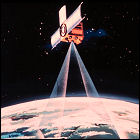 NASA and the National Oceanic & Atmospheric Administration launch NOAA-2, a weather satellite intended to operate in a near-polar low Earth orbit. NOAA-2 is based on the already-flown ITOS satellite design, and will function in orbit through October 1974, with a break of only a few months due to a failed vertical temperature profile radiometer instrument. NOAA-2 will be shut down in January 1975.
NASA and the National Oceanic & Atmospheric Administration launch NOAA-2, a weather satellite intended to operate in a near-polar low Earth orbit. NOAA-2 is based on the already-flown ITOS satellite design, and will function in orbit through October 1974, with a break of only a few months due to a failed vertical temperature profile radiometer instrument. NOAA-2 will be shut down in January 1975.
Venus Orbiter Imaging Radar
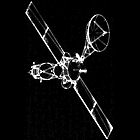 A working group of scientists and engineers at NASA submit an official proposal for a spacecraft using synthetic aperture radar to map the surface of the planet Venus. Conceived as a mission that could be launched from a Titan IIIe or from the space shuttle, both of which still exist only on the drawing board, Venus Orbiter Imaging Radar (or VOIR) is designed to offer extensive mapping of Venus at a resolution much better than the coarse resolution of radar signals originating from Earth-based radio astronomy facilities such as Arecibo, along with such cutting-edge technologies as stereoscopic imaging and solar electric propulsion. Work on this mission will continue through the early 1980s, at which point it is cancelled by NASA and replaced by a cheaper mission intended to achieve the same goals, Magellan.
A working group of scientists and engineers at NASA submit an official proposal for a spacecraft using synthetic aperture radar to map the surface of the planet Venus. Conceived as a mission that could be launched from a Titan IIIe or from the space shuttle, both of which still exist only on the drawing board, Venus Orbiter Imaging Radar (or VOIR) is designed to offer extensive mapping of Venus at a resolution much better than the coarse resolution of radar signals originating from Earth-based radio astronomy facilities such as Arecibo, along with such cutting-edge technologies as stereoscopic imaging and solar electric propulsion. Work on this mission will continue through the early 1980s, at which point it is cancelled by NASA and replaced by a cheaper mission intended to achieve the same goals, Magellan.
Orbiting Astronomical Observatory 3: Copernicus
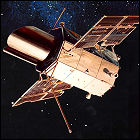 NASA launches the third and final Orbiting Astronomical Observatory satellite, given the nickname “Copernicus” when it successfully enters service near the 500th anniversary of the birth of the famed astronomer of the same name. OAO-3 is a joint venture between NASA and universities in the U.S. and the U.K., again focusing largely on ultraviolet observation of the sky, and it is instrumental in the discovery and study of long-period pulsars. OAO-3 will remain in service through February 1981, its successful nine-year mission lending weight to the ongoing construction and planning of NASA’s Space Telescope project, later to be known as the Hubble Space Telescope.
NASA launches the third and final Orbiting Astronomical Observatory satellite, given the nickname “Copernicus” when it successfully enters service near the 500th anniversary of the birth of the famed astronomer of the same name. OAO-3 is a joint venture between NASA and universities in the U.S. and the U.K., again focusing largely on ultraviolet observation of the sky, and it is instrumental in the discovery and study of long-period pulsars. OAO-3 will remain in service through February 1981, its successful nine-year mission lending weight to the ongoing construction and planning of NASA’s Space Telescope project, later to be known as the Hubble Space Telescope.
Landsat 1
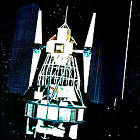 Originally named ERTS-1 (Earth Resource Technology Satellite), NASA’s Landsat satellite, based on the Nimbus weather satellites, is launched to begin constant observations of Earth’s land, air and oceans. Landsat 1’s tour of duty lasts just under six years, during which it discovers a previously unknown island – never before spotted from land or sea – off the northeastern Canadian coast. Landsat 1 remains in service through 1978.
Originally named ERTS-1 (Earth Resource Technology Satellite), NASA’s Landsat satellite, based on the Nimbus weather satellites, is launched to begin constant observations of Earth’s land, air and oceans. Landsat 1’s tour of duty lasts just under six years, during which it discovers a previously unknown island – never before spotted from land or sea – off the northeastern Canadian coast. Landsat 1 remains in service through 1978.
Pioneer 10 plunges into the asteroid belt
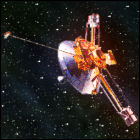 En route to becoming the first human-made spacecraft to visit Jupiter, NASA’s Pioneer 10 also becomes the first human-made spacecraft to enter the asteroid belt between the orbits of Mars and Jupiter. Whether or not the spacecraft will survive this crossing is indeed one of the mission’s major experiments, and is a topic of active debate between scientists with differing views of how densely populated the asteroid belt may be. The spacecraft will survive the crossing without incident.
En route to becoming the first human-made spacecraft to visit Jupiter, NASA’s Pioneer 10 also becomes the first human-made spacecraft to enter the asteroid belt between the orbits of Mars and Jupiter. Whether or not the spacecraft will survive this crossing is indeed one of the mission’s major experiments, and is a topic of active debate between scientists with differing views of how densely populated the asteroid belt may be. The spacecraft will survive the crossing without incident.
Mariner Jupiter/Saturn ’77
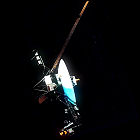 Having spent six years wrangling with various mission profiles for a “Grand Tour” of the outer solar system, made possible by a favorable planetary alignment occurring only once every 175 years, NASA finally authorizes a very stripped-down version of its original ambitious Grand Tour plans. The Mariner Jupiter/Saturn ’77 mission will consist of two twin unmanned spacecraft to be launched in 1977, each on a course to explore Jupiter, and then to use Jupiter’s gravity to deflect them to Saturn. These spacecraft will be renamed Voyager 1 and Voyager 2 just a few months before lifting off.
Having spent six years wrangling with various mission profiles for a “Grand Tour” of the outer solar system, made possible by a favorable planetary alignment occurring only once every 175 years, NASA finally authorizes a very stripped-down version of its original ambitious Grand Tour plans. The Mariner Jupiter/Saturn ’77 mission will consist of two twin unmanned spacecraft to be launched in 1977, each on a course to explore Jupiter, and then to use Jupiter’s gravity to deflect them to Saturn. These spacecraft will be renamed Voyager 1 and Voyager 2 just a few months before lifting off.
Pioneer 10 launched
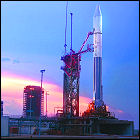 NASA launches Pioneer 10, the first spacecraft sent to study the huge planet Jupiter at close range. Its Atlas-Centaur booster gives it a good head start, propelling it to over 32,000 miles per hour en route to Jupiter, the fastest man-made object in history at this point. Pioneer 10 is also the first man-made vehicle to traverse the asteroid belt, with instruments detecting fewer large particles than anticipated. It will reach Jupiter in late 1973.
NASA launches Pioneer 10, the first spacecraft sent to study the huge planet Jupiter at close range. Its Atlas-Centaur booster gives it a good head start, propelling it to over 32,000 miles per hour en route to Jupiter, the fastest man-made object in history at this point. Pioneer 10 is also the first man-made vehicle to traverse the asteroid belt, with instruments detecting fewer large particles than anticipated. It will reach Jupiter in late 1973.
Luna 20
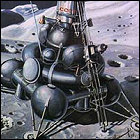 The Soviet Union launches unmanned space probe Luna 20 toward the moon, another robotic lunar lander with the capability of gathering a lunar soil sample and returning it to Earth. Over 50 grams of lunar material, including rocky material from the mountainous region near Luna 20’s landing site, are returned to Earth in a shielded re-entry capsule. The lander continues to operate for three days after the sample container is launched back to Earth.
The Soviet Union launches unmanned space probe Luna 20 toward the moon, another robotic lunar lander with the capability of gathering a lunar soil sample and returning it to Earth. Over 50 grams of lunar material, including rocky material from the mountainous region near Luna 20’s landing site, are returned to Earth in a shielded re-entry capsule. The lander continues to operate for three days after the sample container is launched back to Earth.
Mariner 9 at Phobos
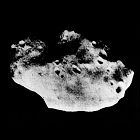 NASA’s Mariner 9 Mars orbiter becomes the first spacecraft to provide relatively close-up images of Mars’ innermost, larger moon, Phobos, from over 3,500 miles away. The irregular shape and heavily cratered surface of Phobos point up its likely origins as an asteroid that long ago came close enough to Mars to be captured into an orbit. Phobos (and its still unseen-at-close-range smaller sibling, Deimos) will be imaged at much closer range later in the 1970s by the Viking orbiters.
NASA’s Mariner 9 Mars orbiter becomes the first spacecraft to provide relatively close-up images of Mars’ innermost, larger moon, Phobos, from over 3,500 miles away. The irregular shape and heavily cratered surface of Phobos point up its likely origins as an asteroid that long ago came close enough to Mars to be captured into an orbit. Phobos (and its still unseen-at-close-range smaller sibling, Deimos) will be imaged at much closer range later in the 1970s by the Viking orbiters.
Mariner 9 at Mars
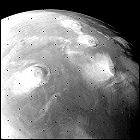 The unmanned NASA/JPL space probe Mariner 9 enters orbit around Mars, becoming the first human spacecraft to orbit another planet in the solar system. The probe begins a nearly year-long survey of the red planet, mapping over 70% of its surface at a much higher resolution than was achieved by the previous NASA Mars probes, Mariners 6 and 7. Mariner 9’s mapping mission is temporarily delayed by a global dust storm obscuring the entire planet when the orbiter arrives. Among its discoveries are Olympus Mons, the solar system’s largest volcano, and the gigantic canyon later named Valles Marineris. Mariner 9 also gathers images of Mars’ two moons, Phobos and Deimos.
The unmanned NASA/JPL space probe Mariner 9 enters orbit around Mars, becoming the first human spacecraft to orbit another planet in the solar system. The probe begins a nearly year-long survey of the red planet, mapping over 70% of its surface at a much higher resolution than was achieved by the previous NASA Mars probes, Mariners 6 and 7. Mariner 9’s mapping mission is temporarily delayed by a global dust storm obscuring the entire planet when the orbiter arrives. Among its discoveries are Olympus Mons, the solar system’s largest volcano, and the gigantic canyon later named Valles Marineris. Mariner 9 also gathers images of Mars’ two moons, Phobos and Deimos.
Luna 19
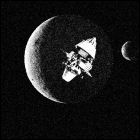 The Soviet Union launches unmanned space probe Luna 19 toward the moon, a return to orbital-only missions. Over the course of a year, Luna 19 conducts an extensive mapping campaign of the lunar surface, as well as measuring gravitational anomalies in lunar orbit.
The Soviet Union launches unmanned space probe Luna 19 toward the moon, a return to orbital-only missions. Over the course of a year, Luna 19 conducts an extensive mapping campaign of the lunar surface, as well as measuring gravitational anomalies in lunar orbit.
Luna 18
 The Soviet Union launches unmanned space probe Luna 18 toward the moon, intended to repeat Luna 16’s feat of gathering and returning a sample of lunar soil to Earth. After spending nearly a week in orbit, Luna 18 descends to the surface, but ground controllers have directed it toward a hazardous mountain region, and contact is lost at the moment the vehicle signals contact with the ground – very likely a sign of a crash landing. No further communication is received from Luna 18, nor is the sample container ever sent back to Earth.
The Soviet Union launches unmanned space probe Luna 18 toward the moon, intended to repeat Luna 16’s feat of gathering and returning a sample of lunar soil to Earth. After spending nearly a week in orbit, Luna 18 descends to the surface, but ground controllers have directed it toward a hazardous mountain region, and contact is lost at the moment the vehicle signals contact with the ground – very likely a sign of a crash landing. No further communication is received from Luna 18, nor is the sample container ever sent back to Earth.
N1 Flight #3
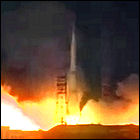 Though the race to the moon has already been lost, the Soviet space program continues to refine its giant N1 rocket, conducting extensive modifications to nearly all of its systems. The third N1 to lift off almost immediately loses directional control, forcing ground controllers to signal it to self-destruct less than a mile off the ground. Its cargo is an unmanned Soyuz/Korabl combo – the Soviet answer to the Apollo command/service module and landing module – though this time there is no launch escape system, so the vehicle is destroyed along with its booster.
Though the race to the moon has already been lost, the Soviet space program continues to refine its giant N1 rocket, conducting extensive modifications to nearly all of its systems. The third N1 to lift off almost immediately loses directional control, forcing ground controllers to signal it to self-destruct less than a mile off the ground. Its cargo is an unmanned Soyuz/Korabl combo – the Soviet answer to the Apollo command/service module and landing module – though this time there is no launch escape system, so the vehicle is destroyed along with its booster.
Mariner 9 launched
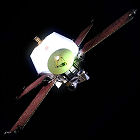 NASA and JPL launch Mariner 9, the only surviving specimen of two identical “Mars ’71” orbiters designed to visit Mars (Mariner 8 has already been launched and then lost in a launch accident). After nearly six months of travel, Mariner 9 will take up permanent residence around the red planet.
NASA and JPL launch Mariner 9, the only surviving specimen of two identical “Mars ’71” orbiters designed to visit Mars (Mariner 8 has already been launched and then lost in a launch accident). After nearly six months of travel, Mariner 9 will take up permanent residence around the red planet.
Mariner 8 launched… and lost
 NASA and JPL launch Mariner 8, the first of two identical “Mars ’71” orbiters designed to visit Mars. Where previous missions have simply flown past the red planet, Mariners 8 and 9 are intended to put themselves in orbit and remain there to map the majority of the Martian surface. The second stage of the Atlas-Centaur booster used to launch Mariner 8 fails, however, and the robotic Mars explorer crashes into the Atlantic Ocean. Some of its mission objectives are transferred to the identical Mariner 9, due for launch at the end of the month.
NASA and JPL launch Mariner 8, the first of two identical “Mars ’71” orbiters designed to visit Mars. Where previous missions have simply flown past the red planet, Mariners 8 and 9 are intended to put themselves in orbit and remain there to map the majority of the Martian surface. The second stage of the Atlas-Centaur booster used to launch Mariner 8 fails, however, and the robotic Mars explorer crashes into the Atlantic Ocean. Some of its mission objectives are transferred to the identical Mariner 9, due for launch at the end of the month.
NOAA-1
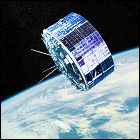 NASA and the newly-rechristened National Oceanic & Atmospheric Administration (formerly ESSA) launch NOAA-1, a weather satellite intended to operate in a near-polar low Earth orbit. Equipped with four cameras, NOAA-1 will operate in orbit for nearly a year before it begins suffering equipment malfunctions. Overheating in the spacecraft’s attitude control system forces ground controllers to turn off some of its weather sensing equipment, and NOAA-1 will eventually be shut down in August 1971.
NASA and the newly-rechristened National Oceanic & Atmospheric Administration (formerly ESSA) launch NOAA-1, a weather satellite intended to operate in a near-polar low Earth orbit. Equipped with four cameras, NOAA-1 will operate in orbit for nearly a year before it begins suffering equipment malfunctions. Overheating in the spacecraft’s attitude control system forces ground controllers to turn off some of its weather sensing equipment, and NOAA-1 will eventually be shut down in August 1971.
Luna 17 and Lunokhod 1
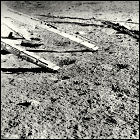 The Soviet Union launches unmanned space probe Luna 17 toward the moon, carrying with it the first automated moon rover, Lunokhod 1. Solar-powered and deployed to the surface via a pair of ramps, the wheeled rover operates for eleven months, more than double the expected operational life span. Unlike Luna 16, Luna 17 and Lunokhod perform their studies of the lunar surface without returning any soil samples to Earth.
The Soviet Union launches unmanned space probe Luna 17 toward the moon, carrying with it the first automated moon rover, Lunokhod 1. Solar-powered and deployed to the surface via a pair of ramps, the wheeled rover operates for eleven months, more than double the expected operational life span. Unlike Luna 16, Luna 17 and Lunokhod perform their studies of the lunar surface without returning any soil samples to Earth.
Zond 8
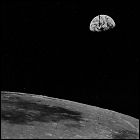 The Soviet Union launches Zond 8, the final Zond flight and the final flight of the Soyuz 7K-L1 capsule which was intended to be the command & service module of the Soviet manned lunar effort. Again, the vehicle orbits the moon and returns to Earth unmanned after a week in space. For only the second time, the 7K-L1 vehicle performs every phase of the flight flawlessly – though the Soviet Union, trying to downplay the space race, now retroactively denies that it was ever interested in sending men to the moon.
The Soviet Union launches Zond 8, the final Zond flight and the final flight of the Soyuz 7K-L1 capsule which was intended to be the command & service module of the Soviet manned lunar effort. Again, the vehicle orbits the moon and returns to Earth unmanned after a week in space. For only the second time, the 7K-L1 vehicle performs every phase of the flight flawlessly – though the Soviet Union, trying to downplay the space race, now retroactively denies that it was ever interested in sending men to the moon.
Luna 16
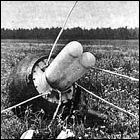 The Soviet Union launches unmanned space probe Luna 16 toward the moon, the first success in the Soviet space program’s ongoing attempt to mount a robotic sample return mission. The lander’s drill-equipped sample collection arm gathers a 35 millimeter, 100-gram core sample of lunar soil, which is then packed into a shielded return capsule for direct return to Earth (seen here after landing). Now claiming that they advocate robotic sample return missions without putting human lives at risk, the Soviets can at last claim a lunar first – the first robotic return to Earth of a soil sample from another body in the solar system.
The Soviet Union launches unmanned space probe Luna 16 toward the moon, the first success in the Soviet space program’s ongoing attempt to mount a robotic sample return mission. The lander’s drill-equipped sample collection arm gathers a 35 millimeter, 100-gram core sample of lunar soil, which is then packed into a shielded return capsule for direct return to Earth (seen here after landing). Now claiming that they advocate robotic sample return missions without putting human lives at risk, the Soviets can at last claim a lunar first – the first robotic return to Earth of a soil sample from another body in the solar system.
Nimbus 4
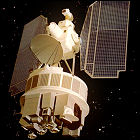 NASA launches the Nimbus 4 satellite, designed to observe weather patterns from orbit and test new weather and climate detection technologies. Nimbus 4 is among the first satellites to test what will become known as global positioning system technology, capable of pinpointing ground-based targets with special equipment. The satellite begins to experience intermittent attitude control problems in 1971, but remains in at least partial service through 1980.
NASA launches the Nimbus 4 satellite, designed to observe weather patterns from orbit and test new weather and climate detection technologies. Nimbus 4 is among the first satellites to test what will become known as global positioning system technology, capable of pinpointing ground-based targets with special equipment. The satellite begins to experience intermittent attitude control problems in 1971, but remains in at least partial service through 1980.
TIROS-M / ITOS
 NASA and ESSA launch the ITOS satellite, also known as TIROS-M, a next-generation weather satellite intended to take over from the constellation of short-lived ESSA weather satellites. With a configuration that is, for the first time, significantly different from the TIROS/ESSA satellites, the TIROS-M design’s shakedown cruise is a short and bumpy one: after system failures force a shutdown of the satellite’s attitude control system, it is shut down in mid-1971.
NASA and ESSA launch the ITOS satellite, also known as TIROS-M, a next-generation weather satellite intended to take over from the constellation of short-lived ESSA weather satellites. With a configuration that is, for the first time, significantly different from the TIROS/ESSA satellites, the TIROS-M design’s shakedown cruise is a short and bumpy one: after system failures force a shutdown of the satellite’s attitude control system, it is shut down in mid-1971.
Apollo 12: more footprints on the moon
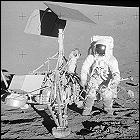 Astronauts Pete Conrad and Alan Bean land on the moon in the Apollo 12 lunar module Intrepid, a mere 600 feet away from the 1967 landing site of the unmanned Surveyor 3 probe. Pieces of Surveyor 3 are gathered for return to Earth to study the effects of prolonged exposure to the lunar environment. Conrad and Bean conduct two moonwalks, each lasting nearly four hours.
Astronauts Pete Conrad and Alan Bean land on the moon in the Apollo 12 lunar module Intrepid, a mere 600 feet away from the 1967 landing site of the unmanned Surveyor 3 probe. Pieces of Surveyor 3 are gathered for return to Earth to study the effects of prolonged exposure to the lunar environment. Conrad and Bean conduct two moonwalks, each lasting nearly four hours.
Viking… to Mars!
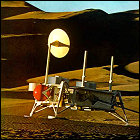 NASA begins making detailed plans for a pair of orbiter/lander spacecraft, now named Viking, to be sent to Mars in the mid 1970s (possibly as early as 1973). With more recent Mariner missions having revealed a number of major challenges, including a thin atmosphere which won’t significantly slow a heavy object such as a landing vehicle, mission planners have to consider entirely new methods of reentry (as opposed to the Earthlike atmosphere that was expected as recently as 1964). The twin Viking spacecraft will not lift off until 1975.
NASA begins making detailed plans for a pair of orbiter/lander spacecraft, now named Viking, to be sent to Mars in the mid 1970s (possibly as early as 1973). With more recent Mariner missions having revealed a number of major challenges, including a thin atmosphere which won’t significantly slow a heavy object such as a landing vehicle, mission planners have to consider entirely new methods of reentry (as opposed to the Earthlike atmosphere that was expected as recently as 1964). The twin Viking spacecraft will not lift off until 1975.
Zond 7
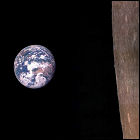 The Soviet Union launches the Zond 7 unmanned spacecraft, an unmanned version of the Soyuz 7K-L1 space vehicle intended to take cosmonauts around the moon. Carrying no crew, this vehicle takes pictures and tests various spacecraft systems without risking human lives. Zond 7 returns to Earth using an unusual multiple-skip atmospheric re-entry profile on August 14th. If Zond 7 had been carrying a crew, this would have been the first nominal flight of the Soyuz 7K-L1 vehicle. No cosmonaut crews would reach the moon prior to the dissolution of the Soviet Union in the late 20th century.
The Soviet Union launches the Zond 7 unmanned spacecraft, an unmanned version of the Soyuz 7K-L1 space vehicle intended to take cosmonauts around the moon. Carrying no crew, this vehicle takes pictures and tests various spacecraft systems without risking human lives. Zond 7 returns to Earth using an unusual multiple-skip atmospheric re-entry profile on August 14th. If Zond 7 had been carrying a crew, this would have been the first nominal flight of the Soyuz 7K-L1 vehicle. No cosmonaut crews would reach the moon prior to the dissolution of the Soviet Union in the late 20th century.
Mariner 7 at Mars
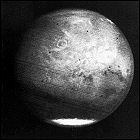 The unmanned NASA/JPL space probe Mariner 7 makes its closest flyby of planet Mars, coming as close as just over 2100 miles from the Martian surface. Having recently suffered an inexplicable but temporary loss of communications with Earth (later determined to be caused by a leaky on-board battery), Mariner 7’s flight plan is reprogrammed just days out from Mars based on some of the more interesting findings of its sister ship, Mariner 6. The success of the tandem flight to Mars convinces NASA to adopt a similar mission profile for the upcoming Mars ’71 missions, which will send two Mariner orbiters to take up permanent positions around Mars.
The unmanned NASA/JPL space probe Mariner 7 makes its closest flyby of planet Mars, coming as close as just over 2100 miles from the Martian surface. Having recently suffered an inexplicable but temporary loss of communications with Earth (later determined to be caused by a leaky on-board battery), Mariner 7’s flight plan is reprogrammed just days out from Mars based on some of the more interesting findings of its sister ship, Mariner 6. The success of the tandem flight to Mars convinces NASA to adopt a similar mission profile for the upcoming Mars ’71 missions, which will send two Mariner orbiters to take up permanent positions around Mars.
Mariner 6 at Mars
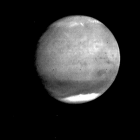 The unmanned NASA/JPL space probe Mariner 6 makes its closest flyby of planet Mars, coming as close as just over 2100 miles from the Martian surface. While measuring the composition of the Martian atmosphere and trying to analyze its surface from space, Mariner 6 passes over densely cratered terrain, not spotting the huge canyons and volcanoes that will later become synonymous with Mars. Mariner 6’s identical twin, Mariner 7, is just days behind it, and ground controllers rewrite Mariner 7’s flight plan to get closer looks at surface features first spotted by Mariner 6.
The unmanned NASA/JPL space probe Mariner 6 makes its closest flyby of planet Mars, coming as close as just over 2100 miles from the Martian surface. While measuring the composition of the Martian atmosphere and trying to analyze its surface from space, Mariner 6 passes over densely cratered terrain, not spotting the huge canyons and volcanoes that will later become synonymous with Mars. Mariner 6’s identical twin, Mariner 7, is just days behind it, and ground controllers rewrite Mariner 7’s flight plan to get closer looks at surface features first spotted by Mariner 6.
Mariner 7: heart-stopper at Mars
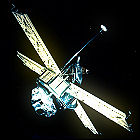 Just two days before its sister ship Mariner 6 makes its closest flyby of Mars, NASA/JPL’s unmanned space explorer Mariner 7 loses all contact with Earth. Ground controllers race to find a solution, re-establishing communications via Mariner 7’s low-gain antenna, which can only return data at a reduced speed and bandwidth. Its high-gain antenna resumes normal operation shortly after Mariner 6’s closest pass by Mars, allowing Mariner 7 to complete its mission as planned.
Just two days before its sister ship Mariner 6 makes its closest flyby of Mars, NASA/JPL’s unmanned space explorer Mariner 7 loses all contact with Earth. Ground controllers race to find a solution, re-establishing communications via Mariner 7’s low-gain antenna, which can only return data at a reduced speed and bandwidth. Its high-gain antenna resumes normal operation shortly after Mariner 6’s closest pass by Mars, allowing Mariner 7 to complete its mission as planned.
Luna 15
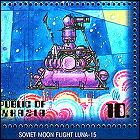 The Soviet Union launches unmanned space probe Luna 15 toward the moon, the Soviet space program’s last attempt to claim a victory in the race to the moon. Intended to land on the moon and gather a core sample of lunar soil which will then be rocketed back to Earth, hopefully ahead of the arrival of lunar soil samples from the concurrent American Apollo 11 moon landing attempt, Luna 15’s lander detaches and attempts its landing on July 20th…only to crash into the moon’s surface, losing all contact with Earth, while NASA astronauts Neil Armstrong and Buzz Aldrin prepare to depart with their soil samples intact. In a rare display of international cooperation, the Soviets shared basic orbital parameters of Luna 15’s flight with NASA to avoid any navigational hazards for Apollo 11.
The Soviet Union launches unmanned space probe Luna 15 toward the moon, the Soviet space program’s last attempt to claim a victory in the race to the moon. Intended to land on the moon and gather a core sample of lunar soil which will then be rocketed back to Earth, hopefully ahead of the arrival of lunar soil samples from the concurrent American Apollo 11 moon landing attempt, Luna 15’s lander detaches and attempts its landing on July 20th…only to crash into the moon’s surface, losing all contact with Earth, while NASA astronauts Neil Armstrong and Buzz Aldrin prepare to depart with their soil samples intact. In a rare display of international cooperation, the Soviets shared basic orbital parameters of Luna 15’s flight with NASA to avoid any navigational hazards for Apollo 11.
N1 Flight #2
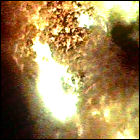 The Soviet Union’s second attempt to launch its moon rocket, the huge N1, ends disastrously. Again carrying an unmanned Zond spacecraft, the N1 barely clears the tower before stalling. Still full of highly flammable fuel, the N1 drops back to the ground, resulting in one of the most powerful man-made, non-nuclear explosions in history, completely wiping its launch tower and adjacent buildings off the map. (The Zond probe is lifted clear of the explosion by its escape rockets.) American spy satellites spot the damage to the nearby landscape from the explosion, tipping off the rest of the world to the N1 rocket program.
The Soviet Union’s second attempt to launch its moon rocket, the huge N1, ends disastrously. Again carrying an unmanned Zond spacecraft, the N1 barely clears the tower before stalling. Still full of highly flammable fuel, the N1 drops back to the ground, resulting in one of the most powerful man-made, non-nuclear explosions in history, completely wiping its launch tower and adjacent buildings off the map. (The Zond probe is lifted clear of the explosion by its escape rockets.) American spy satellites spot the damage to the nearby landscape from the explosion, tipping off the rest of the world to the N1 rocket program.
Nimbus 3
 NASA launches the Nimbus 3 satellite, designed to observe weather patterns from orbit and test new weather and climate detection technologies. Nimbus 3 is the first Earth-orbiting spacecraft to test the SNAP-19 radioisotope thermoelectric generator system; devices similar to the SNAP-19 will become the primary power source for later deep space and outer solar system interplanetary missions. Nimbus 3 loses attitude control in 1970, but is kept online for engineering information-gathering purposes until 1972.
NASA launches the Nimbus 3 satellite, designed to observe weather patterns from orbit and test new weather and climate detection technologies. Nimbus 3 is the first Earth-orbiting spacecraft to test the SNAP-19 radioisotope thermoelectric generator system; devices similar to the SNAP-19 will become the primary power source for later deep space and outer solar system interplanetary missions. Nimbus 3 loses attitude control in 1970, but is kept online for engineering information-gathering purposes until 1972.